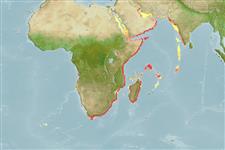Common names from other countries
>
Eupercaria/misc (Various families in series Eupercaria) >
Haemulidae (Grunts) > Haemulinae
Etymology: Pomadasys: Greek, poma, -atos = cover, operculum + Greek, dasys = with hair (Ref. 45335).
More on author: Lacepède.
Environment: milieu / climate zone / depth range / distribution range
Ecologia
marinhas; estuarina associadas(os) a recifes; oceanódromo (Ref. 51243); intervalo de profundidade 0 - 49 m (Ref. 122701). Tropical; 31°N - 37°S, 18°E - 77°E
Southeast Atlantic and Western Indian Ocean: Western and Eastern Cape, South Africa, East Africa, Persian Gulf, Socotra, Seychelles, Madagascar to northwest coast of India.
Length at first maturity / Tamanho / Peso / Idade
Maturity: Lm 38.0 range ? - ? cm
Max length : 80.0 cm TL macho/indeterminado; (Ref. 2799)
Espinhos dorsais (total): 10 - 11; Raios dorsais moles (total): 14-15; Espinhos anais 3; Raios anais moles: 9 - 10. Juveniles without spots on body (Ref. 2799).
Found in coastal waters, estuaries, and tidal fissures; can tolerate freshwater. It can jet a stream of water into the mud to expose crustaceans, worms and small bivalves which it feeds on (Ref. 11441); including fish (Ref. 5213). Tasty food fish (Ref. 2799). Maximum depth range from Ref. 122702.
Life cycle and mating behavior
Maturidade | Reprodução | Desova | Ovos | Fecundidade | Larvas
Oviparous, distinct pairing during breeding (Ref. 205).
Smith, M.M. and R.J. McKay, 1986. Haemulidae. p. 564-571. In M.M. Smith and P.C. Heemstra (eds.) Smiths' sea fishes. Springer-Verlag, Berlin. (Ref. 2799)
Categoria na Lista Vermelha da IUCN (Ref. 130435)
CITES (Ref. 128078)
Not Evaluated
Ameaça para o homem
Harmless
Utilização humana
Pescarias: espécies comerciais; peixe desportivo: sim
Ferramentas
Relatórios especiais
Descarregue XML
Fontes da internet
Estimates based on models
Preferred temperature (Ref.
115969): 22 - 27.9, mean 26.8 (based on 146 cells).
Phylogenetic diversity index (Ref.
82804): PD
50 = 0.5000 [Uniqueness, from 0.5 = low to 2.0 = high].
Bayesian length-weight: a=0.01905 (0.01221 - 0.02973), b=2.95 (2.82 - 3.08), in cm Total Length, based on LWR estimates for this species & Genus-body shape (Ref.
93245).
Nível Trófico (Ref.
69278): 3.5 ±0.2 se; based on diet studies.
Resiliência (Ref.
120179): Baixo, tempo mínimo de duplicação da população 4,5 - 14 anos (K=0.07-0.42).
Fishing Vulnerability (Ref.
59153): Low to moderate vulnerability (34 of 100).
